Introduction:
When completing the interior design of your home, there are numerous factors to consider. Searching for long-lasting, practical, and visually appealing materials would be best. Installing skirting or baseboards on your walls is a crucial decision you can make. The lowest portion of the wall, where it meets the floor, is covered with skirting boards. Skirting is an interior part of a home or structure that covers the seam where the floor meets the wall. It defines the bottom portion of a wall next to a floor as a baseboard or skirting board. Additionally, it is secured to the wall on both sides. These baseboards come in various forms that may be used for residential, commercial, or any.
What is Skirting?
Skirting is one of the most crucial components of civil engineering. Almost all homes, businesses, industrial buildings, etc., have skirting built into them. In most cases, skirting is a board that runs the wall length where it meets the inside wall. The numerous disputed areas of the wall or floor generated during their construction, such as crooked edges of the wall or floor, are often covered by skirting, which gives a good & well-finished appearance. Many materials may be used extensively to build skirting; wooden skirting, metal skirting, pencil skirting, etc., are used extensively for this purpose.
Purpose of Skirting:
- To prevent harm to the intersection of the floor and wall.
- avoiding scratching the walls when sweeping and vacuuming..
- Cover the void between the wall and the floor.
- Provide space between the wall and the furniture to improve the home’s aesthetic appeal.
- Keep furniture free of stains.
- Cover up any open or exposed wiring inside.
Types of Skirting in Construction:
1. Wooden Skirting:
Wooden skirting is a terrific solution for granite, marble, or tiles floors. They give the property a sophisticated aspect. Wooden skirting is also used in ceilings, walls, and light flooring. Wooden skirting is employed in classic interiors. On the market, wooden skirting comes in various sizes and styles. It comes in a variety of colors and designs.. Wooden skirting is appealing and is used for aesthetic purposes.
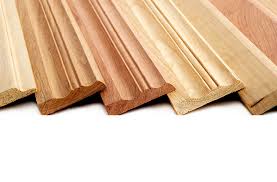
Fig1: Wood Skirting
Courtesy: timber2udirect.co.uk
2. Metal Skirting:
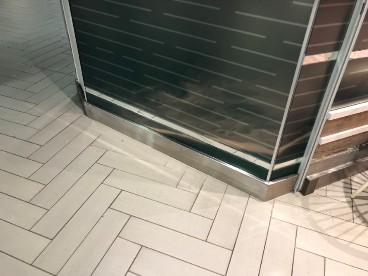
Fig2: Metal Skirting
Courtesy: floorandwallsolutions.co.uk
Metal skirting is an excellent solution for increasing the height of your home’s façade. It is frequently used with cement, which may be applied to the metal skirt’s bottom. This style is typically made of stainless steel, which gives it a gleaming aspect. Although all metals have remarkable endurance, this product should not be damaged by storms or other weather conditions.
3. Pencil Skirting:
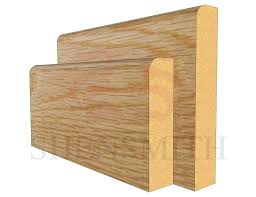
Fig3: Pencil Skirting
Courtesy: skirtingboards.com
Pencil skirting is an excellent design choice for a space that wishes to have a clean, complete look. Pencil skirting is utilized to disguise the expansion gap while creating a smooth and clean surface. This skirting is utilized on both plain and textured or patterned walls. The upper border of pencil skirting is usually rounded.
4. Flush Skirting:
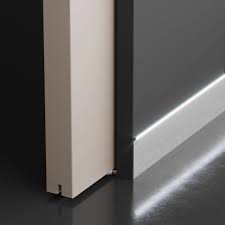
Fig4: Flush Skirting
Courtesy: skirtingboards.com
The flush skirting board gives the property a unified appearance. The skirting and walls, in this case, are on the same floor level. As a result, the main advantage of these types of skirting is that they do not easily transport dust like other forms of skirting that remain extended out of the wall. These skirting kinds save floor space and allow furniture to be arranged to suit the wall perfectly.
5. Plaster Skirting:
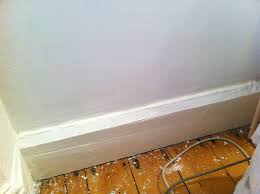
Fig5: Plaster Skirting
Courtesy: flickr.com
Plaster skirting is a distinct form of skirting board. It improves the walls and gives them a more modern and attractive aspect, and this skirting breaks up the smoothness of the plaster and hardwood floor in the wall.
6. Continued Skirting:
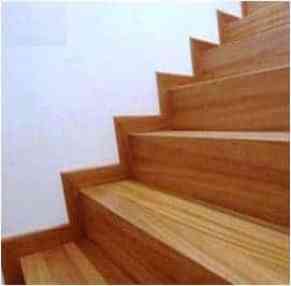
Fig6: Continued Skirting
Courtesy: engineeringlearn.com
If you want to offer color uniformity across the area, continuous skirting is an excellent alternative. Because it continues even if another structure is adjacent to the walls, such as a stairwell, this baseboard design can be utilized with any other structural feature, such as a staircase or related fixtures. It is only achievable if you have employed wallpaper and kept the color scheme consistent with your home’s interior decor.
7. Bullnose Skirting:
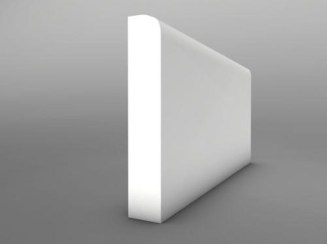
Fig7: Bullnose Skirting
Courtesy: elegantbuildingsupplies.com.au
Bullnose skirting is utilized to give the property a contemporary and attractive appearance. Bullnose skirting boards are available in various standard heights ranging from 50mm to 300mm. The major benefit of bullnose skirting is that it requires little care and is simple to clean. It is suitable for any interior.
8. Movable Floor Skirting:
Movable floor skirting is an innovative kind of floor skirting. It is installed behind the cabinet and contains a concealed locker. When closed, the drawers mimic the skirting beneath the cupboard. This design style is a one-of-a-kind option for modest city apartments.
9. MDF Skirting:
Medium Density Fiber (MDF) skirting is becoming increasingly popular due to several advantages. It is the greatest alternative for individuals on a tight budget who do not want to spend extra money on finishing. It helps you to get the necessary degree of quality while keeping within your budget. It is a good alternative to real wood, natural fibers, and synthetic wood. MDF, in reality, is easily stained or painted and available in various hues ranging from natural light wood to mahogany.
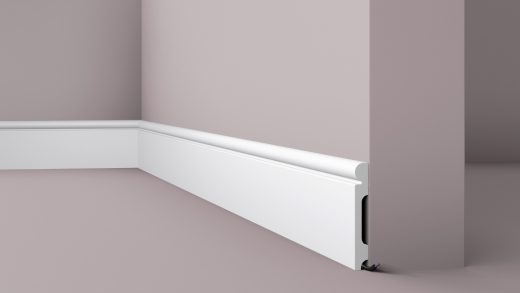
Fig8: MDF Skirting
Courtesy: hackzhub.com
10. Colored Skirting:
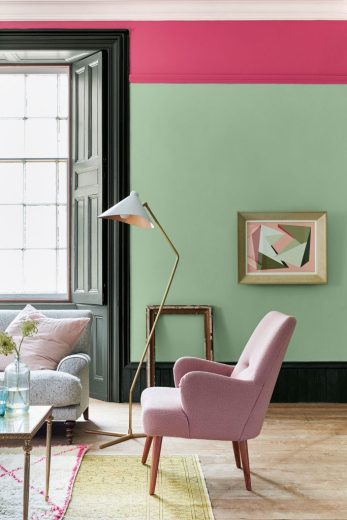
Fig9: Colored Skirting
Courtesy theanamumdiary.co.uk
Colored skirting is also quite popular due to its appealing and brilliant colors. Customers are drawn to color skirting because it has diverse color patterns, textures, and so forth. Colored skirting adds to the interior elegance of the room. Sometimes the same color skirting boards are used throughout the room, and other times a different color is employed.
11. Double-Layer Skirting:
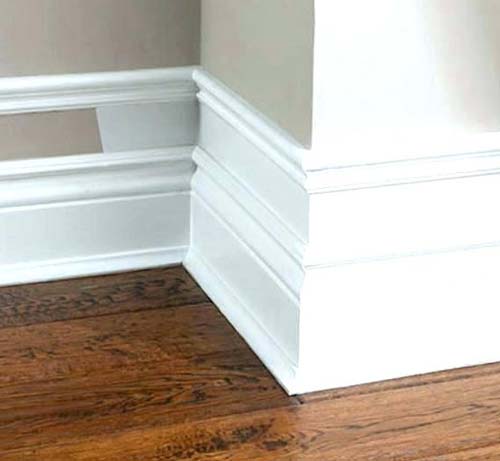
Fig10: Double-Layer Skirting
Courtesy: builder.id
Double-layered skirting is made of two layers. The skirting board’s bottom layer hangs on the wall, while the top layer bends outward over the floor. These two layers’ tops should overlap with a small space between them. The primary concept behind this sort of skirt is to keep dust, rainfall, leaves, and other debris out of your home.
12. PVC Skirting:
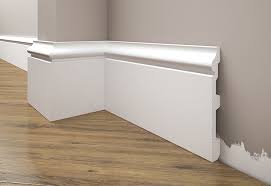
Fig11: PVC Skirting
Courtesy: : beta.com.mt
PVC skirting is fastened or attached to the base of the ground dividers. PVC skirting sheets may be recolored or painted, making them easily adaptable. The perforations between the floor and the divider are hidden with PVC skirting boards. It provides you with partitions and a finished appearance. It also provides excellent resistance against water, dampness, scrapes, and scratches.
Advantages of Skirting:
- It keeps the walls from directly touching the furniture and wall cabinets by leaving some space between them.
- Skirting provides your interiors with a highly clean and elegant appearance.
- Skirting is used to disguise unsightly elements on the wall, such as pipes, ducts, and electrical wires.
- It is used to protect the wall from water and dampness.
- It is incredibly simple to install and comes in various sizes and patterns.
- It conceals the area between the floor and the wall.
- It keeps the painted surface from being stained.
Conclusion:
Skirting is one of the most important components in building construction. Skirting is used in practically every residential construction, business building, contemporary structure, and so forth. A more utilitarian reason for skirting boards is to protect the wall from abrasion, unintended thumps from furniture, wear and tear, and so on. They may also be used to conceal an unsightly wall or messy floor edge. When selecting a baseboard, it is essential to consider the cost since costs vary according to size, material, etc. You must select the ideal one for your needs while keeping cost in mind but without sacrificing quality.
References:
1. admin. “What Is Skirting in Construction and What Does It Do?” Web of Concrete, 13 Sept. 2021, webofconcrete.com/skirting.
2. admin. “12 Types of Skirting – How to Choose the Right Skirting Boards for Your Home? [Explained With Complete Details].” Engineering Learn, 7 Jan. 2023, engineeringlearn.com/types-of-skirting.
3. “Types of Skirting | Skirting Wall Design.” Types of Skirting | Skirting Wall Design,
www.constructioncost.co/skirting-in-construction.html. Accessed 20 Jan. 2023.
4. admin. “Skirting in Building Construction: Types and Purpose – Industry Tap.” Industry Tap, 8 Aug. 2021, www.industrytap.com/skirting-in-building-construction-types-and-purpose/58813.
5. Tameerkaro. “Skirting in Construction With Its 10 Different Types.” Blogs, 26 Feb. 2022, blogs.tameerkaro.com/skirting-in-construction-10-different-types.
6. admin. “Purposes and Types of Skirting in Building Construction.” Civil Bright, 23 Dec. 2022, civilbright.com/purposes-and-types-of-skirting-in-building-construction.
If you have a query, you can ask a question here.


